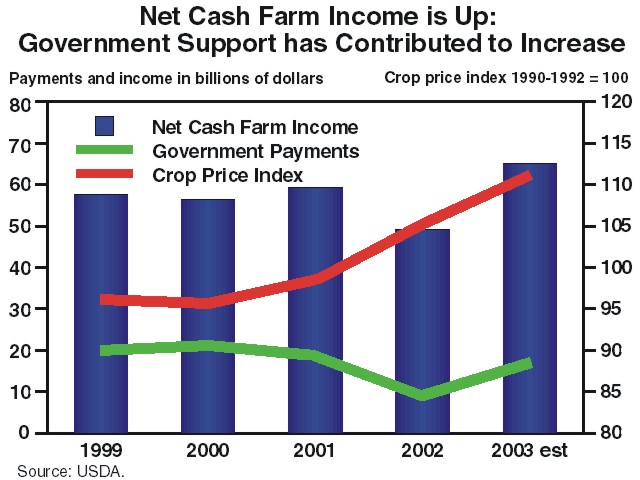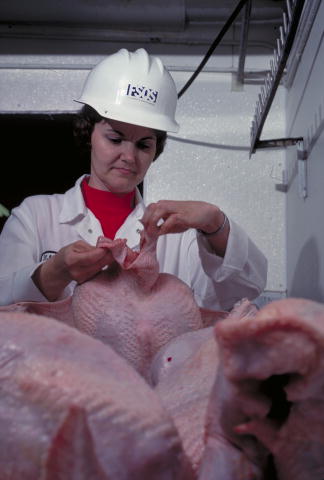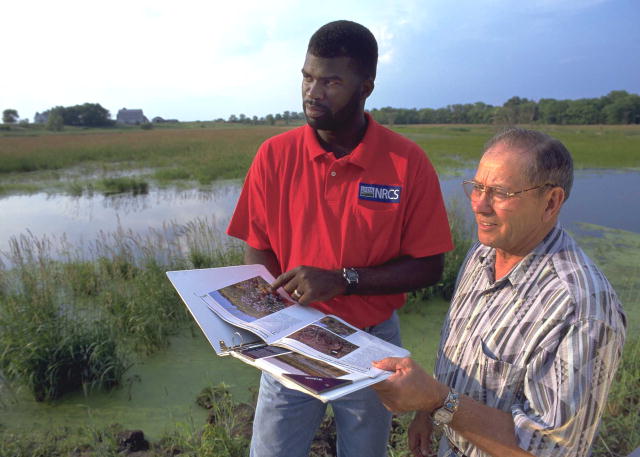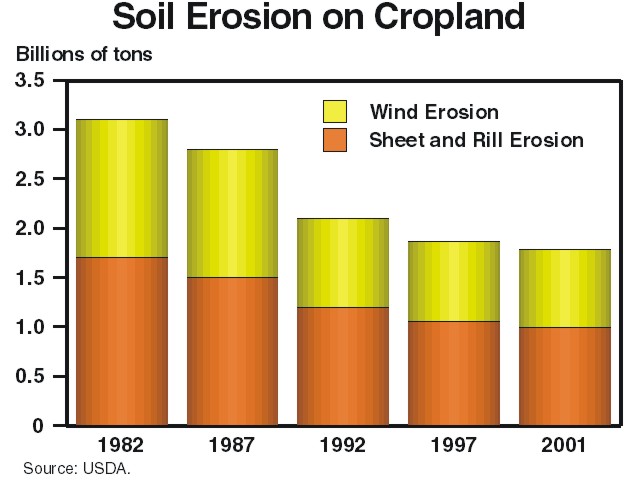 |
||||||
|
||||||
| |||||||||||||||||
|
|
|||||||||||||||||
The United States Department of Agriculture (USDA) implements programs that meet a wide range of the Nation’s needs. The Department promotes agricultural production and trade; protects animal and plant health; works to assure food safety; protects natural resources; fosters strong rural communities; and fights hunger in America and abroad. For example, the Department:
Provides a financial safety net for farmers, insuring an economically sound future for American agriculture;
Provides important nutrition programs, including the Food Stamps, School Lunch, Breakfast, and Child and Adult Care Food programs, and the Special Supplemental Nutrition Program for Women, Infants, and Children (WIC);
Manages National Forests and Grasslands and assists private landowners to manage lands in a productive, sustainable way;
Helps protect public health at 6,430 meat, poultry, and egg product plants by ensuring compliance with food safety standards;
Protects agriculture from pest infestations and disease;
Provides assistance to businesses, housing authorities, electric companies, water supply and sewage treatment facilities and other utilities in rural areas; and
Conducts and sponsors research in areas ranging from food and fiber production to human nutrition and food safety.
USDA plays a critical role in advancing Administration priorities including economic growth, national security and forest health. One result of USDA’s efforts is seen in the economic improvement of the U.S. agricultural sector. Agricultural prices and farm income continue to rise, and agricultural production is also increasing. In addition, it is estimated that the support provided by Rural Development business programs in 2005 will result in the creation or maintenance of nearly 70,000 jobs.
Protecting the Nation’s security includes helping to protect the agricultural industry and food supply from contamination and animal and plant diseases and infestations that can have significant impacts on human health and the economy. The 2005 Budget provides $381 million for the new agriculture and food defense initiatives to increase laboratory capability, monitoring and surveillance, response and recovery, and research to protect the agricultural industry and food supply from terrorist attacks. In addition, competitive peer-reviewed research on a wide range of agricultural issues, including national security, is supported by the National Research Initiative.
Forest health will be improved with more efficient project analysis under the Healthy Forests Initiative, and with increased funding provided to USDA and the Department of the Interior to reduce dense undergrowth that leads to unnaturally large and destructive fires.
The Budget also includes recommendations for improvements in fire suppression management, including cost containment measures. Together, these provide the beginning of a long-term solution to reduce the risk of catastrophic wildfires and the damage and disruptions they cause.
During 2005, USDA will also increase its efforts to reduce hunger and malnutrition and to improve literacy and primary education as part of the McGovern-Dole International Food for Education and Child Nutrition Program.
 |
The U.S. agricultural economy is the strongest in years. Net cash farm income is estimated to be a record $65 billion in 2003, (including roughly $19.7 billion in Government payments to farmers), $16 billion, or 33 percent, higher than in 2002, 15 percent above the 10-year average, and seven percent above the previous record. This is due primarily to record income from commodity markets, up $17 billion from 2002, resulting from robust production and historically high prices. Farm equity rose to a new record level, and debt ratios remain low.
U.S. milk production continues to grow, even though per capita dairy consumption has declined significantly. To support the price of milk, USDA purchases excess milk production and stores, on average, 22 million 25 kg bags of nonfat dry milk. Most of the nonfat dry milk is purchased from 10 large dairy processing plants in four western States, each with annual Government sales between $18 million to $86 million. The dairy program highlights the challenge to design programs that provide a safety net for farmers but do not distort the market. USDA donates internationally and domestically a portion of the nonfat dry milk that is acquired. Recently, USDA donated nonfat dry milk to acquire kid friendly products, such as shelf-stable, flavored milk for the National School Lunch program.
In 2003, the farm sector is forecast to contribute $100 billion to the U.S. economy in net value-added (value of production less payment to other sectors of the economy), a level exceeding the previous record of $97.7 billion contributed in 1996. With the productivity of U.S. agriculture growing faster than domestic demand, U.S. farmers and agricultural firms rely heavily on export markets to sustain prices and revenue. One in three U.S. farm acres is planted for export. The farming sector depends on export of U.S. commodities for between 20 percent and 30 percent of total farm income annually. Agricultural exports totaled $56.2 billion in 2003 and are forecast at $59.5 billion for 2004, up from $53.3 billion in 2002.
Agricultural exports support jobs on farms, in food processing, in manufacturing, and in the transportation sector. According to USDA, each dollar of agricultural exports generates about $1.50 of additional business activity in supporting sectors. Because a growing share of global agricultural production is traded internationally, international and individual country trade policies are critical to the flow of agricultural products. This is why the Administration is committed to removing trade barriers.
The Administration is actively working to expand U.S. exports not only to help our farmers and ranchers, but also to improve the lives of producers and consumers in the developing world and around the globe. Currently, the United States is negotiating a number of free trade agreements that would enable our farmers to better compete in world markets. For instance, the United States presented an ambitious proposal to the World Trade Organization for multilateral agricultural policy liberalization worldwide. In addition, the proposed Free Trade Area of the Americas would form the largest, most affluent free trade zone in the world, with more than 800 million consumers and $13 trillion in gross domestic product.
More than 800 million people worldwide suffer from hunger and malnutrition. The United States is the world’s leader in international food aid with a goal of addressing a third of global hunger needs. Working with the U.S. Agency for International Development, and non-profit religious and humanitarian organizations, U.S. commodities are used to meet immediate food aid needs, while we seek long-term solutions to alleviate global food insecurity.
During 2003, USDA began implementation of the McGovern-Dole International Food for Education and Child Nutrition Program. This program provides U.S. agricultural commodities and financial and technical assistance to carry out preschool and school feeding programs overseas. It also authorizes maternal, infant, and child nutrition programs with the overall purpose to reduce hunger and malnutrition, and improve literacy and primary education. In 2004, this program is expected to reach 1.25 million women and children, with increases in the 2005 Budget to feed an estimated 1.88 million.
Natural disasters regularly threaten and affect agricultural production. USDA’s crop insurance program is the farmer’s primary risk management tool. The Program Assessment Rating Tool (PART) evaluations and other reviews indicate that crop insurance does a good job of insulating the agricultural community from the vagaries of nature. Claims for losses incurred in the 2003 crop year are expected to be approximately $3.8 billion. Although private insurance companies provide coverage, over half the cost of farmers’ insurance premiums is subsidized to encourage farmer participation. Currently, 83 percent of eligible acres are insured by the program, which compares favorably with private sector benchmarks.
On December 23, 2003, USDA announced the discovery of a single BSE positive cow in the United States. There is strong evidence that indicates the cow was imported into the United States. USDA and FDA acted rapidly and aggressively to further strengthen our already extensive BSE protection systems. Since the late 1980s, the United States has had a robust BSE prevention program developed in response to the prevalence of the disease in the United Kingdom and elsewhere. For example, FDA and USDA severely restricted the importation of animals and animal products that pose a possible risk of spreading BSE from high-risk countries. USDA established in 1990 an active surveillance program for evidence of BSE positive cattle. In 1997, FDA instituted a feed ban, which prohibited the feeding of rendered ruminant proteins to other ruminants—believed to be the primary sources of cattle-to-cattle spread of the BSE agent. In total, the USDA and FDA budgets include over $2.9 billion in funding to protect agriculture and the food supply through border and food inspections, monitoring and surveillance for pests and diseases and research to support these functions. As part of this, $34 million is currently dedicated specifically to BSE monitoring and surveillance and research.
In response to the December 23
In order to fully implement these changes, the 2005 Budget proposes $46 million for USDA for increased surveillance and testing, and additional expenses related to the development of an animal identification system. The Budget also includes an increase of $8.3 million at FDA to enhance enforcement of Federal regulations designed to prevent the introduction or spread of BSE.
USDA plays a significant role in protecting America’s agricultural industry and food supply from intentional and unintentional harm. USDA is responsible for protecting the Nation’s resources from plant and animal diseases and pests and inspecting meat, poultry and egg products before they enter the retail food chain. USDA’s Animal and Plant Health Inspection Service (APHIS) monitors the condition of agricultural crops and animals for signs of infestations, and, when appropriate, takes action to eradicate them. In addition, USDA’s Food Safety and Inspection Service is responsible for assuring that meat, poultry and egg products are safe and wholesome and for reducing the risk of food borne illness.
 |
The existing national animal disease research and diagnostic facilities at Ames, Iowa are over 30 years old, have limited usefulness, and no longer meet health and safety requirements. The new Ames facility will combine separate facilities into a single state-of-the-art research and diagnostic facility. This facility will provide modern equipment for testing and for the containment of harmful bacteria and viruses.
Food contamination and animal and plant diseases and infestations can have catastrophic effects on human health and the economy. USDA, the Department of Health and Human Services (HHS) and the Department of Homeland Security (DHS) are working together to create a comprehensive food and agriculture policy that will improve the Government’s ability to respond to the dangers of disease, pests, and poisons, whether they occur naturally or are intentionally introduced.
The 2005 Budget provides $381 million, a $302 million increase, the largest increase ever, for USDA to enhance efforts to quickly respond to food contamination or plant and animal diseases and infestations. USDA will work with HHS and DHS to increase laboratory capacity, research, and monitoring and surveillance. Increases in laboratory capacity will include new methods designed to rapidly identify food contamination or plant and animal diseases, expansion of laboratory networks to ensure that there is the necessary laboratory capability throughout the United States, and improved laboratory connectivity through expanded information technology systems. Though laboratory capacity is an important piece of biosurveillance, other biosurveillance activities include the joint efforts of HHS, DHS and USDA to improve the monitoring of public health data and increases in plant and animal monitoring and surveillance by APHIS. In addition, USDA will increase availability of animal vaccines and establish a National Animal Disease Recovery System.
Research, education, and extension programs are funded at approximately $2.4 billion, including $178 million to complete renovating and modernizing the national animal disease and diagnostic facility at Ames, Iowa. Research will be performed to determine methods for decontaminating food, preventing and responding to disease, and eradicating infestations. The Budget also increases the National Research Initiative competitive grant program, which will continue the Administration’s long-standing commitment to peer-reviewed competitive research.
 |
Over half of USDA’s budget supports nutrition programs for individuals and families in need. These programs include the National School Lunch Program, WIC, and the Food Stamp Program.
The Administration strongly supports child nutrition programs and seeks to ensure that all eligible children are served. The Administration will work with the Congress to make improvements in program integrity without creating barriers and target investments to improve the nutritional quality of meals. The Budget fully funds child nutrition and provides for the extension of a number of expiring provisions to ensure that all aspects of the program continue to operate without interruption.
The Special Supplemental Nutrition Program for Women, Infants and Children, more commonly known as the WIC Program, serves the nutritional needs of low-income pregnant and post-partum women, infants, and children up to their fifth birthday. The President’s Budget reproposes a WIC reauthorization plan to provide $4.8 billion for WIC services, full funding for all those estimated to be eligible and seeking services. In addition, the funds will support: a breastfeeding peer counselor program to target nutrition education and information to increase breastfeeding initiation and duration; test programs to see if WIC can help prevent childhood obesity; an independent, comprehensive evaluation of the effectiveness of the WIC program; and efforts to improve State WIC agencies’ management information systems.
In 2003, the Congress enacted the Administration-proposed contingency fund, which remains available, to ensure that the program can expand to serve an increasing number of eligible persons should that be necessary. If these funds are insufficient, however, the Administration will work with the Congress to ensure eligible individuals seeking services can access this important program.
Breastfeeding is the preferred method of infant feeding in the WIC Program. Studies show a positive correlation between the duration of breastfeeding and infant health. Breastfeeding peer counselors are an effective method of increasing both breastfeeding initiation and duration.
The Texas Breastfeeding Peer Counseling Program promotes and supports breastfeeding to pregnant women and mothers in WIC clinics and hospitals. Since the program began in April 1991, over 2,200 mothers have been trained to be peer counselors. Today there are approximately 300 active peer counselors working in 61 local WIC agencies and 40 hospitals. Breastfeeding rates have increased at all WIC agencies where Peer Counselor programs have been implemented.
Food stamps alleviate hunger and malnutrition among low-income individuals. In 2005, the Food Stamp program will provide approximately $26.3 billion in benefits to 24.9 million people. The Federal Government will provide an additional $4.1 billion for State administrative costs, job training programs for food stamp recipients, and the Puerto Rico Nutrition Assistance block grant.
The President’s Budget includes a common-sense proposal to exclude combat-related military pay when determining food stamp benefits for members of the armed forces. Military personnel receive supplements to their basic pay when they serve in combat. This proposal supports the families of servicemen and servicewomen fighting overseas by ensuring that they do not lose food stamps as a result of this additional income.
The Administration is committed to improving integrity in the Food Stamp Program with a goal of reducing the national average error rate from 8.3 percent for 2002, to 7.4 percent for 2005. This improvement is projected to save as much as $110 million in 2005. The PART evaluation for Food Stamps found that the program is effective overall, but lacks a program strategy to further improve the dietary status of program participants. In 2004, USDA will develop a plan for improving nutrition among food stamp participants.
USDA delivers a portfolio of conservation programs that provides technical and financial assistance to landowners and agricultural managers to protect and enhance natural resources. This assistance helps farmers and ranchers in numerous ways, including reducing soil erosion, protecting water quality, providing for wildlife habitat, and improving the economic return from their operations.
A review of several of the Natural Resources Conservation Service’s (NRCS) programs this year using the PART found that the agency has made progress in measuring the performance of its activities. In general, NRCS uses adequate annual performance measures to evaluate program delivery. However, the agency will continue to work on improving long-term performance and efficiency measures.
 |
Conserving our natural resources is critically important for keeping our Nation’s economy competitive and for solving challenges we face in agriculture and the environment. Over the past two decades, the Department’s principal conservation agency, NRCS, has helped agricultural producers improve resource conditions, such as enhancing water quality. For example, in recent years NRCS and its conservation partners helped to install over 1.5 million miles of vegetative “buffers” along waterways to protect water quality from non-point source pollution (such as sediment, nutrients, pesticides, and pathogens). In addition, work with producers on protecting soil resources has resulted in substantial reductions in the estimated soil erosion over the past 20 years.
 |
In 2002, President Bush signed into law the most conservation-oriented farm bill in history. USDA now has unprecedented new resources to continue to build on its conservation accomplishments. USDA has made great strides in implementing the conservation provisions in the farm bill, such as delivering the expanded Environmental Quality Incentives Program, Conservation Reserve Program, and Wetlands Reserve Program. In 2003 alone, NRCS assisted producers with:
Applying erosion control measures on 5.9 million acres of cultivated cropland that reduced annual soil loss by 50 million tons;
Implementing comprehensive nutrient management systems on 11.9 million acres of grazing land; and
Improving irrigation water management on 1.9 million acres and conserving 5.8 million acre-inches of water.
For decades, a major objective of forest policy has been the containment and prevention of wildfires. The motivations for this policy were good, but the policy has had dangerous consequences. The buildup of underbrush and small trees, combined with drought, has left millions of acres susceptible to large, catastrophic fires that are unnaturally intense. While the President’s Healthy Forests Initiative focuses on management improvements and making better use of existing resources, the Budget also supports the initiative by providing an additional $33 million increase for USDA Forest Service fire fuels reduction projects in 2005.
In August 2002, President Bush announced the Healthy Forests Initiative, a joint effort of USDA and the Department of the Interior designed to reduce the threat of catastrophic wildfire and improve the health of our Nation’s forests and wooded rangelands by expanding local involvement in project selection and reducing unnecessary delays in forest health projects. In just over one year, the Administration completed its promised administrative steps, and also worked with a bipartisan coalition of Members of Congress to pass two new laws to help the agencies better protect communities and forests.
The initiative culminated in the passage of the Healthy Forests Restoration Act, which President Bush signed into law on December 3, 2003. This scientifically-based legislation helps fulfill the President’s pledge to care for America’s forests and rangelands, reduce the risk of catastrophic fire to communities, help save the lives of firefighters and citizens, and protect threatened and endangered species.
The Healthy Forests Initiative marked a clear and decisive change in direction. Instead of enduring season after season of devastating fires my Administration acted to remove the causes of severe wildfires.
The Act:
Strengthens public participation in developing high-priority forest health projects;
Reduces the complexity of environmental analysis, allowing Federal land agencies to use the best science available to actively manage land under their protection;
Provides a more effective appeals process by encouraging early public participation in project planning; and
Issues clear guidance that courts should not enjoin forest health projects unless they have also considered the long-term risks of fire if projects are not completed in a timely manner.
The Act will help provide a long-term solution to reduce the risks of catastrophic wildfires by reducing fire “fuels”—unusually high amount of underbrush and small trees. The Budget puts additional discretion into the hands of on-the-ground managers by funding hazardous fuels activities within the National Forest System at $266 million. Total Forest Service and Department of the Interior funding on these projects has increased four times since 2000. Following the recommendations contained in the PART, the Budget also focuses on ensuring that fuels reduction activities are adequately targeted and efficiently managed. The Budget also reflects anticipated increases in fuels treatments through increased efficiencies resulting from the use of the new stewardship contract authority and other administrative and productivity improvements resulting from the President’s Healthy Forests Initiative.
The buildup in small trees and underbrush not only impacts the health of forests, but also leads to fires that are larger and more costly than those that occur in forests that are in a healthy condition. The cost of fire suppression has risen dramatically. For three out of the last four fiscal years, Federal wildfire suppression costs have exceeded $1 billion per year. While weather and drought undoubtedly played a role in this trend, the rising per-acre costs lead to concerns about targeting of suppression activities and cost-effectiveness of suppression efforts, particularly the use of costly aviation resources. These high costs have a detrimental effect on other Forest Service activities as resources must be redirected from activities such as recreation, endangered species habitat management and protecting sources of clean water to firefighting.
 |
A PART evaluation noted weaknesses in incentives for controlling suppression costs and in the process for allocating preparedness resources effectively. The Budget reflects the PART recommendation that the Forest Service and the Department of the Interior develop and implement cost containment strategies for suppression. In response, these agencies developed new procedures that focus on cost containment strategies in suppressing wildfires and eliminating unnecessary expenses; establishing clearer financial management accountability of personnel; and providing for improved controls and incentives for suppression costs. The Budget builds upon these improvements as well as the integrated use of aviation and personnel resources.
The President’s Budget also maintains the Administration’s fiscally responsible policy of budgeting for the cost of fire suppression at the 10-year average, $685 million. This level reduces the need for supplemental appropriations or Forest Service redirecting resource management funds to fight fires. In addition, this Budget maintains front-line firefighting resources by providing $666 million for fire preparedness.
 |
The Nation’s population has gradually shifted toward urban and suburban centers, with about 20 percent of the population now living in rural surroundings compared with 36 percent just 50 years ago. Despite this migration, rural business, health and personal service industries posted job gains in the past year, although they barely offset job losses in other industries. To help combat these issues, USDA’s rural development loan and grant programs are designed to create jobs and provide the necessary infrastructure, housing and economic development that is needed to improve the quality of life in rural areas. On average, USDA provides over $10 billion in such assistance annually. In addition to several USDA efforts to assist the rural community, the President also has placed a priority on expanding access to care through health centers and supported payment increases to rural Medicare facilities.
One of the important factors for continued development of rural America is infrastructure. Telephone, electricity, water and sewer, schools, libraries, hospitals and fire and rescue services are necessary to attract and maintain rural businesses and residents. In addition, new technology seems to come last to rural areas making it more difficult for them to compete. Programs like the Distance Learning and Telemedicine, and Broadband programs help speed the investments in new technology in rural areas by providing high speed internet access, distance learning facilities and quality medical care that help rural America attract business investment and improve quality of life.
Established in 1847, Anin and Company is the largest and oldest flag manufacturer in the United States. The company’s aging Coshocton, Ohio facility was unable to meet production needs. Rural Development provided a $1.6 million loan guarantee to help Anin purchase and renovate a new building less than 10 minutes from the old facility. The assistance allowed Anin to consolidate production into the new facility and meet peak production needs. This helped sustain the local employer and preserve over 200 jobs.
For 2005, the Budget will provide $527 million in assistance through community facilities grants and loans. The community facilities program provides low interest loans, loan guarantees and grants to rural communities, which help them afford necessary and important facilities such as police stations, medical units, and daycare centers. Through the PART review, community facilities programs were noted for being successful at leveraging funds with other Federal agencies as well as non-governmental agencies, such as faith-based organizations. The Administration is ensuring that any and all barriers to participation within the community facilities program for faith-based organizations are being addressed, so that leveraging and faith-based organization participation is increased.
The Budget continues to focus on improving program performance. Eighteen of USDA’s programs were assessed using the Program Assessment Rating Tool (PART), which evaluated the programs' design and purpose, strategic planning efforts, how well they are managed, and whether they are generating positive results for taxpayers. Below are some of the highlights and recommendations from the PART evaluations. For further details on USDA’s performance assessments, see the White House budget website at www.whitehouse.gov/omb/budget/.
| Program | Rating | Explanation | Recommendation |
|---|---|---|---|
| Animal and Plant Health Inspection Service (APHIS): Monitoring Programs | Effective | Purpose and design are clear and the program is well-managed. Measures focus on key outcomes of the program. | The Budget proposes increases to support detection of significant pest introductions, including BSE, before they spread. |
| Rural Business Service (RBS): Business and Industry Guaranteed Loans | Adequate | While the program has defined good performance goals that measure the number of jobs created and saved, program management needs improvement as the cost of the program has increased over the last few years. | The agency is rewriting regulations to address deficiencies. To provide an understanding of the benefits provided by the program, RBS will be refining its performance measures to compare the types of employment opportunities supported with the economic gain provided to communities. |
| Forest Service: Land Acquisition | Results Not Demonstrated | Although lands are acquired at fair market value, the program needs to establish national priorities that protect public benefits to the greatest extent possible while also providing optimal reduction of Government’s current and future costs. | The Budget proposes that the Forest Service begin conducting analyses of land ecology, vegetation and biodiversity to identify priority areas in need of protection to ensure monies are directed more effectively. |
The table below provides an update on USDA’s implementation of the President’s Management Agenda as of December 31, 2003.
| Human Capital | Competitive Sourcing | Financial Performance | E-Government | Budget and Performance Integration | |
|---|---|---|---|---|---|
| Status | |
|
|
|
|
| Progress | |
|
|
|
|
| USDA developed a comprehensive human capital plan and has worked to develop strategies to address human resource challenges. Additional work is needed, however, to optimize organizational structures and develop department-wide guidance for succession planning as a large proportion of the workforce will be eligible for retirement over the next decade. USDA has completed public-private competitions for over 13 percent of activities eligible to be performed by the private sector. In many instances, USDA employees have won these competitions and overall, competition is improving efficiencies of program delivery. Competitions conducted by the Forest Service on maintenance work on roads, trails and facilities resulted in an estimated savings of $1.5 million annually. USDA’s efforts in financial management resulted in its second clean audit opinion and the resolution of 12 audit weaknesses, though problems associated with funds control still need to be resolved. Efforts during 2003 resulted in a reduction of over 25 percent in the number of information technology systems and over 15 percent in the funding by combining similar systems and reducing duplication. During 2004, USDA will focus on correcting the significant number of information technology security deficiencies. For the first time the USDA budget links resources to program performance and strategic goals. | |||||
| Initiative | Status | Progress |
|---|---|---|
| Faith-Based and Community Initiative | |
|
| USDA will publish a general department-wide rule affirming the ability, rights, and responsibilities of faith-based organizations participating in USDA programs and benefits in accordance with Executive Order 13279. As part of its outreach and technical assistance efforts, USDA has greatly enhanced electronic access to information to encourage faith-based and community-based organizations (FBOs/CBOs) to learn about funding opportunities and apply for grants. USDA is also establishing baseline levels of participation by FBOs/CBOs in specific programs across three USDA mission areas. This information will be used to set goals for increased activity by FBOs/CBOs applying to administer USDA funded programs. USDA is working to ensure that FBOs/CBOs have full access to formula grant programs administered by State and local agencies. | ||
| Actual | Estimate | ||||
|---|---|---|---|---|---|
| 2001 | 2003 | 2004 | 2005 | ||
| Spending | |||||
| Discretionary Budget Authority: | |||||
| Commodities and International | 2,481 | 3,287 | 3,045 | 3,098 | |
| Rural Development | 2,714 | 2,764 | 2,449 | 2,205 | |
| Forest Service | 4,449 | 3,955 | 4,192 | 4,238 | |
| Conservation | 1,017 | 1,016 | 1,028 | 908 | |
| Food and Nutrition Service | 4,483 | 5,085 | 4,930 | 5,142 | |
| Research | 2,120 | 2,492 | 2,468 | 2,404 | |
| Marketing and Regulatory Programs | 1,558 | 1,940 | 1,610 | 1,803 | |
| Central Administration | 448 | 575 | 517 | 631 | |
| Subtotal, excluding items below | 19,270 | 21,114 | 20,239 | 20,429 | |
| Receipts and new user fees | -33 | -43 | -33 | -214 | |
| Emergencies | — | 919 | 523 | — | |
| Mandatory savings proposals | — | — | — | -1,159 | |
| Total, Discretionary budget authority 1 | 19,237 | 21,990 | 20,729 | 19,056 | |
| Total, Discretionary outlays | 17,640 | 20,317 | 21,374 | 20,781 | |
| Mandatory Outlays: | |||||
| Food and Nutrition Service | 28,620 | 36,143 | 40,488 | 42,245 | |
| Commodity Credit Corporation | 24,288 | 17,198 | 14,936 | 15,215 | |
| Crop Insurance | 2,463 | 3,255 | 3,965 | 3,685 | |
| Natural Resources Conservation Service | 24 | 902 | 1,839 | 2,079 | |
| Agriculture Marketing Service | 1,050 | 1,371 | 1,060 | 977 | |
| Forest Service | 809 | 549 | 705 | 705 | |
| Loan liquidating accounts and reestimates | -4,304 | -6,833 | -5,733 | -3,475 | |
| Receipts and all other programs | -2,589 | -717 | -1,022 | -434 | |
| Total, Mandatory outlays | 50,361 | 51,868 | 56,238 | 60,997 | |
| Total, Outlays | 68,001 | 72,185 | 77,612 | 81,778 | |
| Credit activity | |||||
| Direct Loan Disbursements: | |||||
| Farm Loans | 1,072 | 1,100 | 1,035 | 937 | |
| Commodity Credit Corporation | 8,267 | 10,718 | 8,284 | 9,209 | |
| Rural Utilities Service | 2,957 | 4,127 | 4,507 | 4,598 | |
| Rural Housing | 1,212 | 1,134 | 1,494 | 1,369 | |
| Rural Community and Economic Development | 246 | 275 | 371 | 407 | |
| P.L. 480 | 262 | 65 | 301 | 31 | |
| All other programs | 69 | 45 | 91 | 84 | |
| Total, Direct loan disbursements | 14,085 | 17,464 | 16,083 | 16,635 | |
| Guaranteed Loan Commitments: | |||||
| Farm Loans | 2,200 | 2,592 | 2,461 | 2,866 | |
| Commodity Credit Corporation | 2,183 | 2,388 | 4,155 | 4,528 | |
| Rural Utilities Service | 35 | 26 | 212 | 382 | |
| Rural Housing | 2,171 | 3,047 | 2,914 | 2,837 | |
| Rural Business and Community Development | 824 | 795 | 536 | 432 | |
| Total, Guaranteed loan commitments | 7,413 | 8,848 | 10,278 | 11,045 | |
|
|